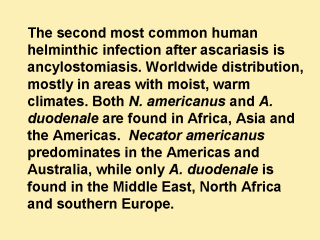| front |1 |2 |3 |4 |5 |6 |7 |8 |9 |10 |11 |12 |13 |14 |15 |16 |17 |18 |19 |review |
 |
Iron deficiency anemia is the most
common symptom of hookworm infection, and can be accompanied by cardiac complications.
Gastrointestinal and nutritional/metabolic symptoms can also occur. In addition, local
skin manifestations can occur during penetration by the filariform (L3) larvas, and
respiratory symptoms can be observed during pulmonary migration of the larvas. Microscopic identification of eggs in the stool is the most common method for diagnosing hookworm infection. The recommended procedure is as follows: 1/ Collect a stool specimen. 2/ Fix the specimen in 10% formalin. 3/ Concentrate using the formalin–ethyl acetate sedimentation technique. 4/ Examine a wet mount of the sediment. Hookworm infections are generally treated with albendazole, mebendazole or pyrantel pamoate. |